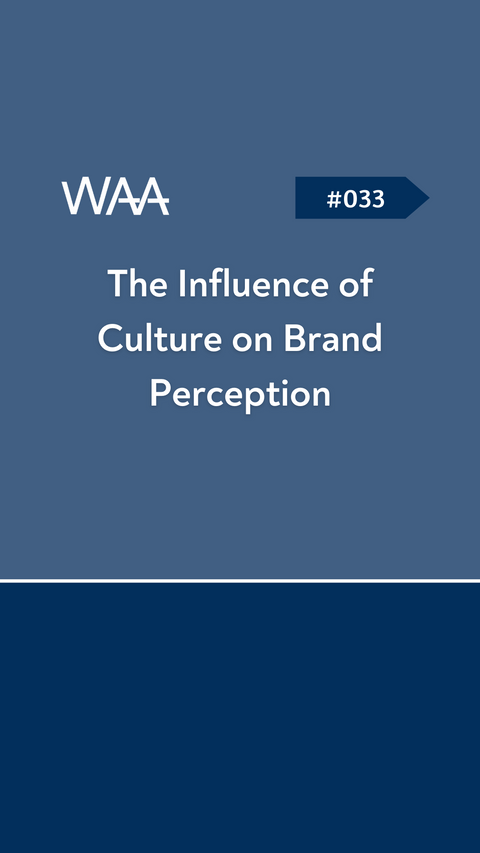
#033 The Influence of Culture on Brand Perception
The Influence of Culture on Brand Perception
In today's globalized marketplace, understanding the influence of culture on brand perception is crucial for businesses aiming to build successful brands and connect with diverse audiences. Culture plays a significant role in shaping consumer behavior, attitudes, and preferences. Brands that can effectively navigate and leverage cultural differences gain a competitive edge in connecting with their target market and creating meaningful brand experiences.
Cultural Sensitivity in Branding
Cultural sensitivity in branding involves recognizing that different cultures have distinct values, beliefs, and customs. It goes beyond simply translating marketing materials into different languages. To create a powerful and resonant brand, businesses need to delve deeper into cultural nuances and tailor their strategies accordingly.
One example highlighting the importance of cultural sensitivity is the difference in color symbolism across cultures. While white is associated with purity and weddings in Western cultures, it symbolizes mourning and death in parts of Asia. Brands must be aware of these differences and adapt their branding elements, such as logos, packaging, and website design, to align with local cultural norms and avoid possible misunderstandings.
Marketing Across Cultures
Marketing across cultures requires a comprehensive understanding of the various cultural factors that influence consumer behavior. Cultural values, social structures, and communication styles all play a role in shaping how people consume and perceive goods and services.
Brands expanding into new markets need to conduct thorough research to gain insights into the cultural preferences and aspirations of their target audience. Consideration should be given to factors such as individualism versus collectivism, the value placed on tradition versus innovation, and the role of family and community in purchasing decisions.
Adapting marketing strategies to fit cultural contexts is essential for success. Localization efforts, such as adapting advertising campaigns, product packaging, and messaging to align with local customs and preferences, can significantly improve consumer receptivity. Brands that demonstrate an understanding and appreciation of local culture can create emotional connections with their audience and gain their trust and loyalty.
Influence Marketing and Cultural Influencers
Influence marketing has emerged as a powerful tool for brands to reach and engage with their target audience. Leveraging social media influencers can be particularly effective, as they have built a following and trust among their followers. However, when employing influencer marketing, brands must also consider cultural differences to ensure authenticity and relatability.
Cultural influencers, who understand and embody the values and aspirations of specific cultures, can be instrumental in bridging the gap between brands and consumers. Collaborating with influencers from the target culture enables businesses to tap into their expertise and established connections, increasing the credibility and impact of their marketing efforts. These influencers can provide valuable insights into cultural nuances and help tailor messages that resonate with the target audience.
However, it's essential to choose influencers who align with the brand's values and messaging. Authenticity is key; the influencer should have a genuine affinity for the brand and an organic connection with their followers. Brands should avoid superficial partnerships solely based on follower count, as they may lack the cultural relevance necessary to effectively influence consumer perception.
Embracing Cultural Diversity and Inclusivity
In a multicultural world, embracing cultural diversity and inclusivity is not only a moral imperative, but it is also good for business. Brands that prioritize inclusivity in their messaging and marketing efforts create a sense of belonging for individuals from different cultural backgrounds.
An excellent example of inclusivity in branding can be seen in Coca-Cola's "Share a Coke" campaign. By personalizing their product packaging with popular names from various cultures, the brand acknowledged and celebrated the diversity of its consumers. This campaign resonated with people of different cultural backgrounds, promoting inclusivity and reinforcing positive brand perception.
Businesses can incorporate cultural diversity and inclusivity in their marketing strategies by showcasing diverse individuals and cultural experiences in their advertisements and using inclusive language and imagery. Collaboration with cultural organizations and sponsoring cultural events are also effective ways to demonstrate support for diverse communities.
Conclusion
Culture has a profound impact on how consumers perceive brands and make purchasing decisions. Brands that recognize, respect, and adapt to cultural differences can create more meaningful and impactful connections with their target audience. Cultural sensitivity in branding includes considering color symbolism, adapting marketing strategies to fit cultural contexts, and leveraging influence marketing with cultural influencers. Embracing cultural diversity and inclusivity further strengthens brand perception and fosters a sense of belonging among consumers. By understanding and utilizing the influence of culture on brand perception, businesses can position themselves for success in the global marketplace.
